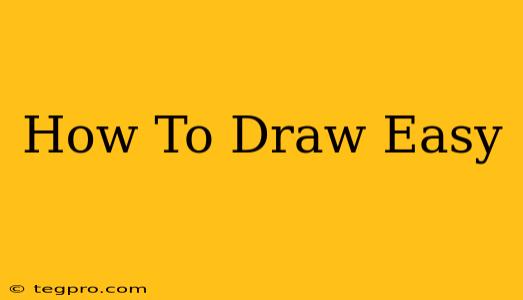So you want to learn how to draw, but the thought feels daunting? Don't worry! Drawing doesn't require years of art school or innate talent. This guide will show you how to draw easy, fun, and surprisingly rewarding pictures, even if you've never picked up a pencil before. We'll cover fundamental techniques and simple exercises to help you build confidence and develop your skills.
Essential Materials: Keeping it Simple
Before we dive into techniques, let's gather our supplies. You don't need expensive art materials to start. In fact, keeping it simple is key when you're learning how to draw easy. Here's what you'll need:
- Pencils: A standard #2 pencil is perfect. You might also consider a softer pencil like a 2B for shading.
- Eraser: A good quality eraser is vital for correcting mistakes (and we all make them!).
- Paper: Any kind of paper will do to start, but drawing paper or sketchbooks are better for practicing.
- Sharpener: Keep your pencils sharp for precise lines.
That's it! No fancy equipment needed for your easy drawing journey.
Basic Shapes: The Building Blocks of Art
Believe it or not, most things you see can be broken down into simple shapes like circles, squares, triangles, and rectangles. Mastering these shapes is the first step in learning how to draw easy.
Practice Exercise: Shape Repetition
- Circles: Spend 5 minutes drawing circles of varying sizes. Don't worry about perfection; focus on the fluidity of your movement.
- Squares: Repeat the same exercise with squares, paying attention to straight lines and right angles.
- Triangles: Draw various triangles, both equilateral and irregular.
- Rectangles: Practice drawing rectangles with different proportions.
This exercise helps develop hand-eye coordination and improves your ability to control your pencil.
From Shapes to Simple Objects: Easy Drawing Techniques
Once you're comfortable with basic shapes, let's combine them to create simple objects.
Drawing a House: A Step-by-Step Guide
- Square: Start with a square for the base of the house.
- Triangle: Add a triangle on top for the roof.
- Rectangles: Draw smaller rectangles for windows and a door.
- Details: Add a chimney and other details as desired.
See? A simple house is just a combination of basic shapes!
Drawing an Apple: Another Easy Example
- Circle: Draw a slightly flattened circle.
- Stem and Leaf: Add a small line at the top for the stem and a tiny leaf.
- Highlight: Leave a small un-shaded area to represent a highlight.
- Shading: Use light shading to give the apple dimension.
Beyond the Basics: Adding Depth and Detail
As you gain confidence, you can start experimenting with more advanced techniques:
- Shading: Learn different shading techniques to add depth and realism to your drawings.
- Perspective: Understand basic perspective to create the illusion of depth and space.
- Line Weight: Vary the thickness of your lines to create visual interest.
Practice Makes Perfect: The Key to Easy Drawing
The most important thing to remember is that practice makes perfect. The more you draw, the better you'll become. Don't be discouraged if your early attempts aren't perfect; it's all part of the learning process.
Tips for consistent practice:
- Set aside dedicated time: Even 15 minutes a day can make a big difference.
- Draw from observation: Draw objects around you to improve your observation skills.
- Experiment with different styles: Don't be afraid to try new things.
- Find inspiration: Look at other artists' work for inspiration but always focus on developing your own style.
- Have fun! Drawing should be enjoyable, so relax and let your creativity flow.
Learning how to draw easy is a journey, not a race. Embrace the process, celebrate your progress, and enjoy the satisfaction of creating something beautiful with your own hands. So grab your pencils and start drawing!

